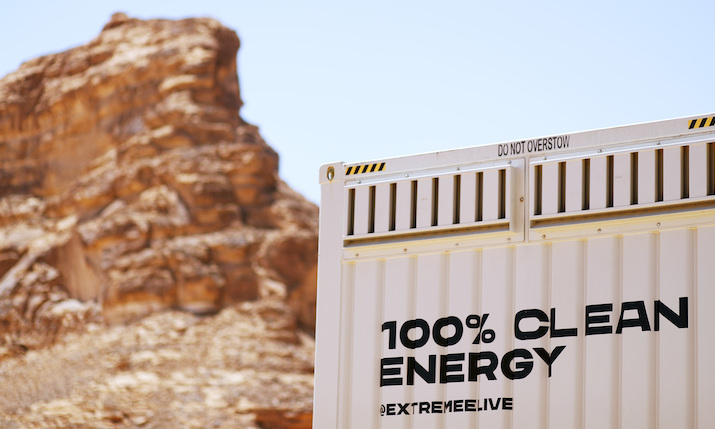Solar and second life batteries power Extreme E broadcasts

An AFC Energy container during the Desert X-Prix in AlUla, Saudi Arabia
Photo by Sam Bloxham / LAT Images
Putting on a motorsport event can be tricky at the best of times, but for Extreme E it presents more challenges than most due to the nature of the locations it visits. Already, the series has visited the Saudi Arabian desert and the beaches of Lac Rose in Senegal, neither of which are home to electricity, WiFi or even toilets, and the next location in Greenland could be even tougher.
Luckily the series is working with a host of innovative and environmentally conscious suppliers to deliver its X Prixs in the toughest of conditions. As a series keeping its carbon footprint as low as possible it has been looking into alternative ways to charge the all-electric SUV – Odyssey 21 – that each team races, but wider than that, the paddock itself.
To achieve this. Power Logistics has provided another four solar powered battery energy storage systems. In the right conditions these provide enough power for the Command Centre – the hub of strategic decision-making during races. The other three battery energy storage systems are used to power TV communication nodes around the course – the devices that transmit the signals all over the world so the TV broadcast can be produced remotely.
Also being utilised is Zenobē and its second-life battery. Once a battery for an electric bus in Sweden, it is now a provider of power to Extreme E, including running all utility power for broadcast, race and event control plus the media centre.
Steven Meersman, Zenobē’s co-founder and director, explained: “Extreme E presented a unique opportunity for us, and we both have a vision to use electrification to enable a cleaner, greener future. We presented the idea of powering the paddock using repurposed batteries and it made perfect sense, showcasing sustainable and responsible consumption, aligned with the aims of the Paris Agreement as we head towards COP26, as well as Extreme E’s aims to be net carbon zero at the end of Season 1.”
And that is where the Zenobē battery comes in, Meersman added: “A second-life battery is one that has served its intended life in an electric vehicle (EV) and has been repurposed or reused in a new application like it has done with Extreme E. Batteries are removed from EVs when they are no longer suitable for powering the vehicle, but they still have life left for further usage.”
If this battery weren’t to be used in this way it would be recycled, however Meersman explained: “Although the recycling industry is gearing up to handle the growing volume of EV batteries, it is costly, energy intensive and not quite 100% effective yet. At Zenobē we are helping the industry buy more time, and by repurposing these batteries we are creating a closed loop system reducing energy usage, waste, mining and the cradle-to-grave carbon footprint of EVs, and demonstrating the value of a circular economy.”
Looking to the future, Zenobē has big plans. Meersman added: “We are looking to scale up our portfolio of second-life battery projects and working with Extreme E to prove the capabilities and benefits of these will support this aim.”
When it comes to charging the SUVs, a collaboration with British-based AFC Energy means all the Odyssey 21s are charged using energy from a hydrogen fuel cell. CEO Adam Bond explained: “The world’s transition to electric vehicles is heavily reliant on electrical grid infrastructure to move electrons from the point of generation to the local charge point.”
So what happens where there is no grid, much like each of Extreme E’s remote locations on the 2021 racing calendar? AFC Energy’s zero emission hydrogen fuel cell generator technology offers a cutting-edge solution that not only produces clean energy to charge the championship’s Odyssey 21s, but is able to do so across a range of the world’s most unforgiving environments.
He continued: “As a purpose-driven series, Extreme E is providing a platform for highlighting what is indeed possible using today’s technology to mitigate against tomorrow’s environmental crisis. By showcasing the potential to transition away from conventional highly pollutant diesel generators, this purpose is leading real change in the way we live and do business, while supporting the tremendous Extreme E spectacle at each race location.”
New for the second X Prix – the Ocean X Prix – in Senegal, AFC Energy delivered its first Hydrogen Production Module which produces hydrogen from water using an electrolyser powered by solar panels. Bond expanded: “This green hydrogen is then fed into the hydrogen fuel cell on race day to produce the energy needed to charge the cars. The whole process, from the generation of hydrogen fuel to the generation of electricity through the fuel cell, is completely sustainable.”
All of these innovations provide some pretty big CO2 savings. The combined use of battery storage and zero-emission car charging provide more than a 95% decrease in carbon emissions.
Extreme E’s utilities manager Andy Welch said: “At Extreme E we have no choice but to confront the challenges of providing clean sustainable energy in remote locations, and the good news is that it is all possible with today’s technology and the suppliers behind you who are willing to demonstrate future energy solutions.”
